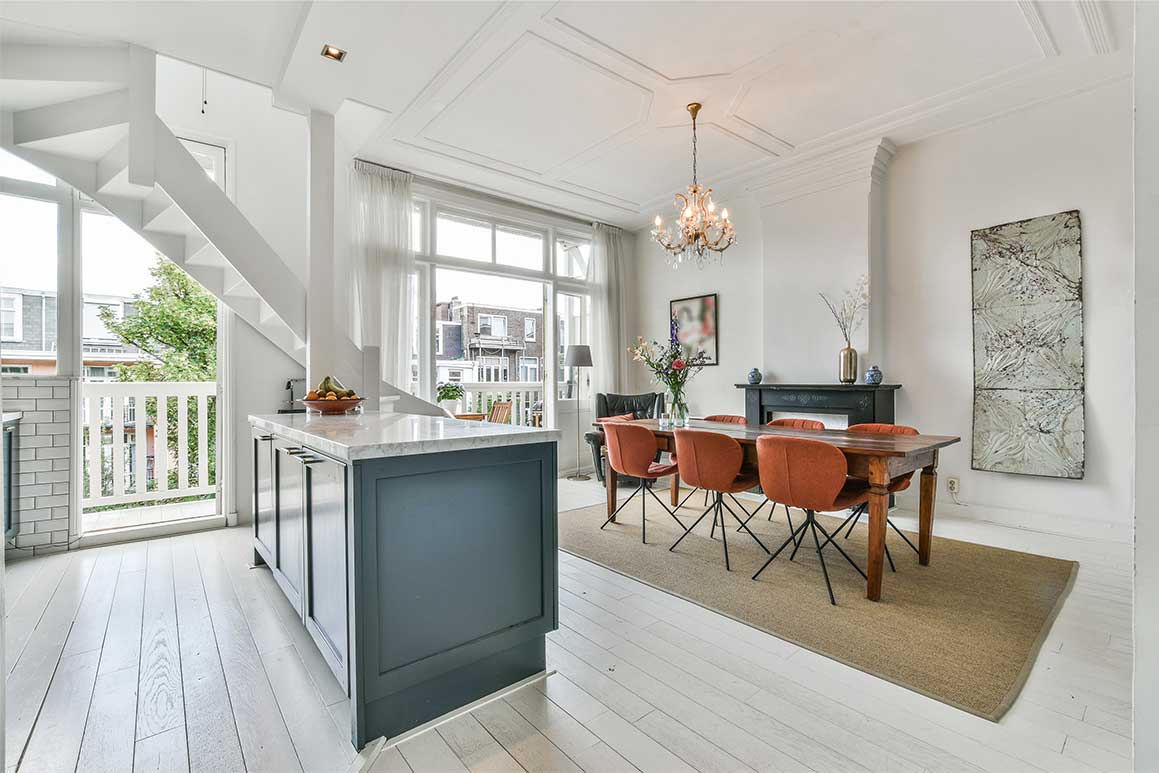 Image source
Selling your home for the first time can overwhelm you with a variety of emotions. After all, there’s plenty running through your mind as you work towards letting go of your current home and moving towards a new one.
With a robust local economy and coastal views to boot, San Diego is an especially lucrative area for turning a profit on real estate investments. In a previous post, we talked about getting your home off the market fast. In this post, we’d like to discuss the actual process of selling your home. If you’re selling your property for the first time, you’ll likely be curious about what to expect. The more you understand about the steps involved, the better prepared you’ll be. With that in mind, here’s what you can expect from the home selling process:
Step 1: Choose Your Agent
Choosing your agent is always the first step of the buying and selling process. Agents help steer you throughout the process, price your home at the best value and negotiate on your behalf, and save you plenty of time and stress. Your agent will advocate for you throughout your selling journey, and ease your transition as you plan to move from one place to the next.
Step 2: Create a Plan
Planning the next few steps is crucial to selling a home. Your agent will sit down with you to discuss the timeline you’re looking to sell, necessary inspections that need to take place, the paperwork you should be expecting to handle, potential home marketing tactics, and much more.
This is where the agent will also price your home at a fair value. Pricing your home the right way is critical; many home sellers who choose to forego having an agent on board (or don’t have a knowledgeable agent on their side) make the critical mistake of pricing their home too high or too low. The right home price is a highly strategic decision based on market research, data, and an accurate home value assessments.
Step 3: Prep Your Home & List Your Property
Once you’ve created a custom home selling plan with your agent, you’ll get your home market-ready and officially list your home for sale on listing services. To get your home market ready, there are several steps you should take. Sometimes, this involves making a few tweaks and renovations. If you have a budget in place for renovations, you should focus on value-boosting renovation projects that have strong return on investments. Your agent will help you determine which areas of the home you should focus on, and where you can get the most for your money.
Any marketing that will help boost the appeal of your listing will also come into play here. For instance, professional home staging and photography will go a long way towards boosting the attractiveness of your listing. The goal is to make your home attractive to a versatile set of potential buyers, and there are several tips and tricks that can be leveraged to make this possible. Rearranging furniture will maximize space perception, while simple landscaping adjustments will improve curb appeal and value perception.
Lastly, marketing your home involves much more than putting up a “For Sale” sign. Depending on your agent, there are several ways you can advertise your property and widen your reach to get as many interested buyers as possible.
Step 4: Host Open Houses
Open houses are an integral part of the selling process. Your agent is responsible for setting up, promoting, and running your open houses. As you may already understand from your own home purchase, open houses allow potential buyers to tour the home. From the seller’s side, there’s a bit more work involved. For starters, you’ll need to set your home up to appeal to visiting buyers. You’ll choose a time and date that works best to maximize foot traffic in your home, and your agent will develop brochures and circulate your open house event information as needed.
Creating an ideal open house environment is also a process in itself. Potential buyers should be able to walk into a property and have all fives senses fully immersed. They can also offer valuable feedback that your agent can use to improve future open houses. But most importantly, your agent is able to capture each visitor as a lead, and gain a thorough understanding of where each buyer is in the home search process, reaching out when necessary.
Step 5: Discuss Offers
Once you start getting offers on your home, you have to entertain each of them and make smart decisions. The goal is to get you the best terms with the shortest turnaround time. Depending on the pricing strategy you choose, you’ll sit down and look at them during certain dates, or discuss offers with your agent as they come. Either way, your agent will do their best to create a favorable situation that makes you happy!
Step 6: Enter Escrow & Due Diligence
Once you’ve accepted the right offer, the deal goes into escrow, where the buyer’s funds are held securely by a third party. Typically, within three days of entering escrow, the buyer will submit their deposit (usually around 3% of the purchase price). You’ll be given the preliminary title report on the home.
The due diligence portion of the process allows the buyer to further investigate your home and ensure there are no undisclosed issues. During this time, both you and the buyer are working towards getting your contingencies removed, and the seller’s disclosures are prepared for buyers to review. They’ll receive any necessary documentation as the lender works on the loan and orders an appraisal of your home.
Step 7: Closing
Finally, the documents are finalized and you’ve officially sold your home. By now, you should have moved the rest of your belongings out of the property and into your new home!
Image source
Selling your home for the first time can overwhelm you with a variety of emotions. After all, there’s plenty running through your mind as you work towards letting go of your current home and moving towards a new one.
With a robust local economy and coastal views to boot, San Diego is an especially lucrative area for turning a profit on real estate investments. In a previous post, we talked about getting your home off the market fast. In this post, we’d like to discuss the actual process of selling your home. If you’re selling your property for the first time, you’ll likely be curious about what to expect. The more you understand about the steps involved, the better prepared you’ll be. With that in mind, here’s what you can expect from the home selling process:
Step 1: Choose Your Agent
Choosing your agent is always the first step of the buying and selling process. Agents help steer you throughout the process, price your home at the best value and negotiate on your behalf, and save you plenty of time and stress. Your agent will advocate for you throughout your selling journey, and ease your transition as you plan to move from one place to the next.
Step 2: Create a Plan
Planning the next few steps is crucial to selling a home. Your agent will sit down with you to discuss the timeline you’re looking to sell, necessary inspections that need to take place, the paperwork you should be expecting to handle, potential home marketing tactics, and much more.
This is where the agent will also price your home at a fair value. Pricing your home the right way is critical; many home sellers who choose to forego having an agent on board (or don’t have a knowledgeable agent on their side) make the critical mistake of pricing their home too high or too low. The right home price is a highly strategic decision based on market research, data, and an accurate home value assessments.
Step 3: Prep Your Home & List Your Property
Once you’ve created a custom home selling plan with your agent, you’ll get your home market-ready and officially list your home for sale on listing services. To get your home market ready, there are several steps you should take. Sometimes, this involves making a few tweaks and renovations. If you have a budget in place for renovations, you should focus on value-boosting renovation projects that have strong return on investments. Your agent will help you determine which areas of the home you should focus on, and where you can get the most for your money.
Any marketing that will help boost the appeal of your listing will also come into play here. For instance, professional home staging and photography will go a long way towards boosting the attractiveness of your listing. The goal is to make your home attractive to a versatile set of potential buyers, and there are several tips and tricks that can be leveraged to make this possible. Rearranging furniture will maximize space perception, while simple landscaping adjustments will improve curb appeal and value perception.
Lastly, marketing your home involves much more than putting up a “For Sale” sign. Depending on your agent, there are several ways you can advertise your property and widen your reach to get as many interested buyers as possible.
Step 4: Host Open Houses
Open houses are an integral part of the selling process. Your agent is responsible for setting up, promoting, and running your open houses. As you may already understand from your own home purchase, open houses allow potential buyers to tour the home. From the seller’s side, there’s a bit more work involved. For starters, you’ll need to set your home up to appeal to visiting buyers. You’ll choose a time and date that works best to maximize foot traffic in your home, and your agent will develop brochures and circulate your open house event information as needed.
Creating an ideal open house environment is also a process in itself. Potential buyers should be able to walk into a property and have all fives senses fully immersed. They can also offer valuable feedback that your agent can use to improve future open houses. But most importantly, your agent is able to capture each visitor as a lead, and gain a thorough understanding of where each buyer is in the home search process, reaching out when necessary.
Step 5: Discuss Offers
Once you start getting offers on your home, you have to entertain each of them and make smart decisions. The goal is to get you the best terms with the shortest turnaround time. Depending on the pricing strategy you choose, you’ll sit down and look at them during certain dates, or discuss offers with your agent as they come. Either way, your agent will do their best to create a favorable situation that makes you happy!
Step 6: Enter Escrow & Due Diligence
Once you’ve accepted the right offer, the deal goes into escrow, where the buyer’s funds are held securely by a third party. Typically, within three days of entering escrow, the buyer will submit their deposit (usually around 3% of the purchase price). You’ll be given the preliminary title report on the home.
The due diligence portion of the process allows the buyer to further investigate your home and ensure there are no undisclosed issues. During this time, both you and the buyer are working towards getting your contingencies removed, and the seller’s disclosures are prepared for buyers to review. They’ll receive any necessary documentation as the lender works on the loan and orders an appraisal of your home.
Step 7: Closing
Finally, the documents are finalized and you’ve officially sold your home. By now, you should have moved the rest of your belongings out of the property and into your new home!

Everything You Need to Know About Selling Your Home for the First Time
By Mclain Properties Sunday, September 22, 2019
 Image source
Selling your home for the first time can overwhelm you with a variety of emotions. After all, there’s plenty running through your mind as you work towards letting go of your current home and moving towards a new one.
With a robust local economy and coastal views to boot, San Diego is an especially lucrative area for turning a profit on real estate investments. In a previous post, we talked about getting your home off the market fast. In this post, we’d like to discuss the actual process of selling your home. If you’re selling your property for the first time, you’ll likely be curious about what to expect. The more you understand about the steps involved, the better prepared you’ll be. With that in mind, here’s what you can expect from the home selling process:
Step 1: Choose Your Agent
Choosing your agent is always the first step of the buying and selling process. Agents help steer you throughout the process, price your home at the best value and negotiate on your behalf, and save you plenty of time and stress. Your agent will advocate for you throughout your selling journey, and ease your transition as you plan to move from one place to the next.
Step 2: Create a Plan
Planning the next few steps is crucial to selling a home. Your agent will sit down with you to discuss the timeline you’re looking to sell, necessary inspections that need to take place, the paperwork you should be expecting to handle, potential home marketing tactics, and much more.
This is where the agent will also price your home at a fair value. Pricing your home the right way is critical; many home sellers who choose to forego having an agent on board (or don’t have a knowledgeable agent on their side) make the critical mistake of pricing their home too high or too low. The right home price is a highly strategic decision based on market research, data, and an accurate home value assessments.
Step 3: Prep Your Home & List Your Property
Once you’ve created a custom home selling plan with your agent, you’ll get your home market-ready and officially list your home for sale on listing services. To get your home market ready, there are several steps you should take. Sometimes, this involves making a few tweaks and renovations. If you have a budget in place for renovations, you should focus on value-boosting renovation projects that have strong return on investments. Your agent will help you determine which areas of the home you should focus on, and where you can get the most for your money.
Any marketing that will help boost the appeal of your listing will also come into play here. For instance, professional home staging and photography will go a long way towards boosting the attractiveness of your listing. The goal is to make your home attractive to a versatile set of potential buyers, and there are several tips and tricks that can be leveraged to make this possible. Rearranging furniture will maximize space perception, while simple landscaping adjustments will improve curb appeal and value perception.
Lastly, marketing your home involves much more than putting up a “For Sale” sign. Depending on your agent, there are several ways you can advertise your property and widen your reach to get as many interested buyers as possible.
Step 4: Host Open Houses
Open houses are an integral part of the selling process. Your agent is responsible for setting up, promoting, and running your open houses. As you may already understand from your own home purchase, open houses allow potential buyers to tour the home. From the seller’s side, there’s a bit more work involved. For starters, you’ll need to set your home up to appeal to visiting buyers. You’ll choose a time and date that works best to maximize foot traffic in your home, and your agent will develop brochures and circulate your open house event information as needed.
Creating an ideal open house environment is also a process in itself. Potential buyers should be able to walk into a property and have all fives senses fully immersed. They can also offer valuable feedback that your agent can use to improve future open houses. But most importantly, your agent is able to capture each visitor as a lead, and gain a thorough understanding of where each buyer is in the home search process, reaching out when necessary.
Step 5: Discuss Offers
Once you start getting offers on your home, you have to entertain each of them and make smart decisions. The goal is to get you the best terms with the shortest turnaround time. Depending on the pricing strategy you choose, you’ll sit down and look at them during certain dates, or discuss offers with your agent as they come. Either way, your agent will do their best to create a favorable situation that makes you happy!
Step 6: Enter Escrow & Due Diligence
Once you’ve accepted the right offer, the deal goes into escrow, where the buyer’s funds are held securely by a third party. Typically, within three days of entering escrow, the buyer will submit their deposit (usually around 3% of the purchase price). You’ll be given the preliminary title report on the home.
The due diligence portion of the process allows the buyer to further investigate your home and ensure there are no undisclosed issues. During this time, both you and the buyer are working towards getting your contingencies removed, and the seller’s disclosures are prepared for buyers to review. They’ll receive any necessary documentation as the lender works on the loan and orders an appraisal of your home.
Step 7: Closing
Finally, the documents are finalized and you’ve officially sold your home. By now, you should have moved the rest of your belongings out of the property and into your new home!
Image source
Selling your home for the first time can overwhelm you with a variety of emotions. After all, there’s plenty running through your mind as you work towards letting go of your current home and moving towards a new one.
With a robust local economy and coastal views to boot, San Diego is an especially lucrative area for turning a profit on real estate investments. In a previous post, we talked about getting your home off the market fast. In this post, we’d like to discuss the actual process of selling your home. If you’re selling your property for the first time, you’ll likely be curious about what to expect. The more you understand about the steps involved, the better prepared you’ll be. With that in mind, here’s what you can expect from the home selling process:
Step 1: Choose Your Agent
Choosing your agent is always the first step of the buying and selling process. Agents help steer you throughout the process, price your home at the best value and negotiate on your behalf, and save you plenty of time and stress. Your agent will advocate for you throughout your selling journey, and ease your transition as you plan to move from one place to the next.
Step 2: Create a Plan
Planning the next few steps is crucial to selling a home. Your agent will sit down with you to discuss the timeline you’re looking to sell, necessary inspections that need to take place, the paperwork you should be expecting to handle, potential home marketing tactics, and much more.
This is where the agent will also price your home at a fair value. Pricing your home the right way is critical; many home sellers who choose to forego having an agent on board (or don’t have a knowledgeable agent on their side) make the critical mistake of pricing their home too high or too low. The right home price is a highly strategic decision based on market research, data, and an accurate home value assessments.
Step 3: Prep Your Home & List Your Property
Once you’ve created a custom home selling plan with your agent, you’ll get your home market-ready and officially list your home for sale on listing services. To get your home market ready, there are several steps you should take. Sometimes, this involves making a few tweaks and renovations. If you have a budget in place for renovations, you should focus on value-boosting renovation projects that have strong return on investments. Your agent will help you determine which areas of the home you should focus on, and where you can get the most for your money.
Any marketing that will help boost the appeal of your listing will also come into play here. For instance, professional home staging and photography will go a long way towards boosting the attractiveness of your listing. The goal is to make your home attractive to a versatile set of potential buyers, and there are several tips and tricks that can be leveraged to make this possible. Rearranging furniture will maximize space perception, while simple landscaping adjustments will improve curb appeal and value perception.
Lastly, marketing your home involves much more than putting up a “For Sale” sign. Depending on your agent, there are several ways you can advertise your property and widen your reach to get as many interested buyers as possible.
Step 4: Host Open Houses
Open houses are an integral part of the selling process. Your agent is responsible for setting up, promoting, and running your open houses. As you may already understand from your own home purchase, open houses allow potential buyers to tour the home. From the seller’s side, there’s a bit more work involved. For starters, you’ll need to set your home up to appeal to visiting buyers. You’ll choose a time and date that works best to maximize foot traffic in your home, and your agent will develop brochures and circulate your open house event information as needed.
Creating an ideal open house environment is also a process in itself. Potential buyers should be able to walk into a property and have all fives senses fully immersed. They can also offer valuable feedback that your agent can use to improve future open houses. But most importantly, your agent is able to capture each visitor as a lead, and gain a thorough understanding of where each buyer is in the home search process, reaching out when necessary.
Step 5: Discuss Offers
Once you start getting offers on your home, you have to entertain each of them and make smart decisions. The goal is to get you the best terms with the shortest turnaround time. Depending on the pricing strategy you choose, you’ll sit down and look at them during certain dates, or discuss offers with your agent as they come. Either way, your agent will do their best to create a favorable situation that makes you happy!
Step 6: Enter Escrow & Due Diligence
Once you’ve accepted the right offer, the deal goes into escrow, where the buyer’s funds are held securely by a third party. Typically, within three days of entering escrow, the buyer will submit their deposit (usually around 3% of the purchase price). You’ll be given the preliminary title report on the home.
The due diligence portion of the process allows the buyer to further investigate your home and ensure there are no undisclosed issues. During this time, both you and the buyer are working towards getting your contingencies removed, and the seller’s disclosures are prepared for buyers to review. They’ll receive any necessary documentation as the lender works on the loan and orders an appraisal of your home.
Step 7: Closing
Finally, the documents are finalized and you’ve officially sold your home. By now, you should have moved the rest of your belongings out of the property and into your new home!





